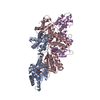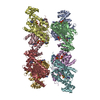[English] 日本語
 Yorodumi
Yorodumi- PDB-5ujm: Structure of the active form of human Origin Recognition Complex ... -
+ Open data
Open data
- Basic information
Basic information
| Entry | Database: PDB / ID: 5ujm | ||||||
|---|---|---|---|---|---|---|---|
| Title | Structure of the active form of human Origin Recognition Complex and its ATPase motor module | ||||||
 Components Components | (Origin recognition complex subunit ... ) x 5 ) x 5 | ||||||
 Keywords Keywords |  REPLICATION / ORC / REPLICATION / ORC /  ATPase ATPase | ||||||
| Function / homology |  Function and homology information Function and homology informationpolar body extrusion after meiotic divisions / CDC6 association with the ORC:origin complex /  origin recognition complex / E2F-enabled inhibition of pre-replication complex formation / inner kinetochore / nuclear origin of replication recognition complex / nuclear pre-replicative complex / DNA replication preinitiation complex / neural precursor cell proliferation / mitotic DNA replication checkpoint signaling ...polar body extrusion after meiotic divisions / CDC6 association with the ORC:origin complex / origin recognition complex / E2F-enabled inhibition of pre-replication complex formation / inner kinetochore / nuclear origin of replication recognition complex / nuclear pre-replicative complex / DNA replication preinitiation complex / neural precursor cell proliferation / mitotic DNA replication checkpoint signaling ...polar body extrusion after meiotic divisions / CDC6 association with the ORC:origin complex /  origin recognition complex / E2F-enabled inhibition of pre-replication complex formation / inner kinetochore / nuclear origin of replication recognition complex / nuclear pre-replicative complex / DNA replication preinitiation complex / neural precursor cell proliferation / mitotic DNA replication checkpoint signaling / G1/S-Specific Transcription / origin recognition complex / E2F-enabled inhibition of pre-replication complex formation / inner kinetochore / nuclear origin of replication recognition complex / nuclear pre-replicative complex / DNA replication preinitiation complex / neural precursor cell proliferation / mitotic DNA replication checkpoint signaling / G1/S-Specific Transcription /  DNA replication origin binding / DNA replication origin binding /  regulation of DNA replication / DNA replication initiation / protein polymerization / Activation of the pre-replicative complex / glial cell proliferation / regulation of DNA replication / DNA replication initiation / protein polymerization / Activation of the pre-replicative complex / glial cell proliferation /  heterochromatin / Activation of ATR in response to replication stress / Assembly of the ORC complex at the origin of replication / Assembly of the pre-replicative complex / Orc1 removal from chromatin / heterochromatin / Activation of ATR in response to replication stress / Assembly of the ORC complex at the origin of replication / Assembly of the pre-replicative complex / Orc1 removal from chromatin /  DNA replication / DNA replication /  chromosome, telomeric region / chromosome, telomeric region /  nuclear body / nuclear body /  nucleotide binding / nucleotide binding /  centrosome / centrosome /  chromatin binding / chromatin binding /  chromatin / chromatin /  nucleolus / negative regulation of transcription by RNA polymerase II / nucleolus / negative regulation of transcription by RNA polymerase II /  ATP hydrolysis activity / ATP hydrolysis activity /  DNA binding / DNA binding /  nucleoplasm / nucleoplasm /  ATP binding / ATP binding /  membrane / membrane /  metal ion binding / metal ion binding /  nucleus / nucleus /  cytosol cytosolSimilarity search - Function | ||||||
| Biological species |   Homo sapiens (human) Homo sapiens (human) | ||||||
| Method |  ELECTRON MICROSCOPY / ELECTRON MICROSCOPY /  single particle reconstruction / single particle reconstruction /  cryo EM / Resolution: 18 Å cryo EM / Resolution: 18 Å | ||||||
 Authors Authors | Tocilj, A. / On, K. / Yuan, Z. / Sun, J. / Elkayam, E. / Li, H. / Stillman, B. / Joshua-Tor, L. | ||||||
 Citation Citation |  Journal: Elife / Year: 2017 Journal: Elife / Year: 2017Title: Structure of the active form of human origin recognition complex and its ATPase motor module. Authors: Ante Tocilj / Kin Fan On / Zuanning Yuan / Jingchuan Sun / Elad Elkayam / Huilin Li / Bruce Stillman / Leemor Joshua-Tor /  Abstract: Binding of the Origin Recognition Complex (ORC) to origins of replication marks the first step in the initiation of replication of the genome in all eukaryotic cells. Here, we report the structure of ...Binding of the Origin Recognition Complex (ORC) to origins of replication marks the first step in the initiation of replication of the genome in all eukaryotic cells. Here, we report the structure of the active form of human ORC determined by X-ray crystallography and cryo-electron microscopy. The complex is composed of an ORC1/4/5 motor module lobe in an organization reminiscent of the DNA polymerase clamp loader complexes. A second lobe contains the ORC2/3 subunits. The complex is organized as a double-layered shallow corkscrew, with the AAA+ and AAA+-like domains forming one layer, and the winged-helix domains (WHDs) forming a top layer. CDC6 fits easily between ORC1 and ORC2, completing the ring and the DNA-binding channel, forming an additional ATP hydrolysis site. Analysis of the ATPase activity of the complex provides a basis for understanding ORC activity as well as molecular defects observed in Meier-Gorlin Syndrome mutations. | ||||||
| History |
|
- Structure visualization
Structure visualization
| Movie |
 Movie viewer Movie viewer |
|---|---|
| Structure viewer | Molecule:  Molmil Molmil Jmol/JSmol Jmol/JSmol |
- Downloads & links
Downloads & links
- Download
Download
| PDBx/mmCIF format |  5ujm.cif.gz 5ujm.cif.gz | 367.1 KB | Display |  PDBx/mmCIF format PDBx/mmCIF format |
|---|---|---|---|---|
| PDB format |  pdb5ujm.ent.gz pdb5ujm.ent.gz | 274.8 KB | Display |  PDB format PDB format |
| PDBx/mmJSON format |  5ujm.json.gz 5ujm.json.gz | Tree view |  PDBx/mmJSON format PDBx/mmJSON format | |
| Others |  Other downloads Other downloads |
-Validation report
| Arichive directory |  https://data.pdbj.org/pub/pdb/validation_reports/uj/5ujm https://data.pdbj.org/pub/pdb/validation_reports/uj/5ujm ftp://data.pdbj.org/pub/pdb/validation_reports/uj/5ujm ftp://data.pdbj.org/pub/pdb/validation_reports/uj/5ujm | HTTPS FTP |
|---|
-Related structure data
| Related structure data |  8541MC  8523C  5uj7C  5uj8C M: map data used to model this data C: citing same article ( |
|---|---|
| Similar structure data |
- Links
Links
- Assembly
Assembly
| Deposited unit | 
|
|---|---|
| 1 |
|
- Components
Components
-Origin recognition complex subunit ... , 5 types, 5 molecules ABCDE
| #1: Protein |  / Replication control protein 1 / Replication control protein 1Mass: 58729.707 Da / Num. of mol.: 1 / Fragment: UNP residues 471-861 Source method: isolated from a genetically manipulated source Details: Strep-strep-SUMO-tagged / Source: (gene. exp.)   Homo sapiens (human) / Gene: ORC1, ORC1L, PARC1 Homo sapiens (human) / Gene: ORC1, ORC1L, PARC1Production host:  Spodoptera aff. frugiperda 2 RZ-2014 (butterflies/moths) Spodoptera aff. frugiperda 2 RZ-2014 (butterflies/moths)References: UniProt: Q13415 |
|---|---|
| #2: Protein |  Mass: 40309.777 Da / Num. of mol.: 1 Source method: isolated from a genetically manipulated source Source: (gene. exp.)   Homo sapiens (human) / Gene: ORC2, ORC2L Homo sapiens (human) / Gene: ORC2, ORC2LProduction host:  Spodoptera aff. frugiperda 2 RZ-2014 (butterflies/moths) Spodoptera aff. frugiperda 2 RZ-2014 (butterflies/moths)References: UniProt: Q13416 |
| #3: Protein |  / Origin recognition complex subunit Latheo / Origin recognition complex subunit LatheoMass: 82436.133 Da / Num. of mol.: 1 Source method: isolated from a genetically manipulated source Source: (gene. exp.)   Homo sapiens (human) / Gene: ORC3, LATHEO, ORC3L Homo sapiens (human) / Gene: ORC3, LATHEO, ORC3LProduction host:  Spodoptera aff. frugiperda 2 RZ-2014 (butterflies/moths) Spodoptera aff. frugiperda 2 RZ-2014 (butterflies/moths)References: UniProt: Q9UBD5 |
| #4: Protein |  Mass: 50443.266 Da / Num. of mol.: 1 Source method: isolated from a genetically manipulated source Source: (gene. exp.)   Homo sapiens (human) / Gene: ORC4, ORC4L Homo sapiens (human) / Gene: ORC4, ORC4LProduction host:  Spodoptera aff. frugiperda 2 RZ-2014 (butterflies/moths) Spodoptera aff. frugiperda 2 RZ-2014 (butterflies/moths)References: UniProt: O43929 |
| #5: Protein |  Mass: 50349.934 Da / Num. of mol.: 1 Source method: isolated from a genetically manipulated source Source: (gene. exp.)   Homo sapiens (human) / Gene: ORC5, ORC5L Homo sapiens (human) / Gene: ORC5, ORC5LProduction host:  Spodoptera aff. frugiperda 2 RZ-2014 (butterflies/moths) Spodoptera aff. frugiperda 2 RZ-2014 (butterflies/moths)References: UniProt: O43913 |
-Non-polymers , 2 types, 5 molecules 


| #6: Chemical |  Adenosine triphosphate Adenosine triphosphate#7: Chemical | |
|---|
-Experimental details
-Experiment
| Experiment | Method:  ELECTRON MICROSCOPY ELECTRON MICROSCOPY |
|---|---|
| EM experiment | Aggregation state: PARTICLE / 3D reconstruction method:  single particle reconstruction single particle reconstruction |
- Sample preparation
Sample preparation
| Component | Name: Human ORC / Type: COMPLEX / Details: Human Origin Recognition Complex / Entity ID: #1-#5 / Source: RECOMBINANT |
|---|---|
| Source (natural) | Organism:   Homo sapiens (human) Homo sapiens (human) |
| Source (recombinant) | Organism:  Spodoptera aff. frugiperda 2 RZ-2014 (butterflies/moths) Spodoptera aff. frugiperda 2 RZ-2014 (butterflies/moths)Plasmid  : PFl, PSPL, PUCDM : PFl, PSPL, PUCDM |
| Buffer solution | pH: 7.5 |
| Specimen | Embedding applied: NO / Shadowing applied: NO / Staining applied : NO / Vitrification applied : NO / Vitrification applied : YES : YES |
Vitrification | Cryogen name: ETHANE |
- Electron microscopy imaging
Electron microscopy imaging
| Experimental equipment |  Model: Titan Krios / Image courtesy: FEI Company |
|---|---|
| Microscopy | Model: FEI TITAN KRIOS |
| Electron gun | Electron source : :  FIELD EMISSION GUN / Accelerating voltage: 300 kV / Illumination mode: FLOOD BEAM FIELD EMISSION GUN / Accelerating voltage: 300 kV / Illumination mode: FLOOD BEAM |
| Electron lens | Mode: BRIGHT FIELD Bright-field microscopy Bright-field microscopy |
| Image recording | Electron dose: 50 e/Å2 / Film or detector model: GATAN K2 SUMMIT (4k x 4k) |
- Processing
Processing
| EM software |
| ||||||||||||||||||||||||||||||||||||||||||||||||
|---|---|---|---|---|---|---|---|---|---|---|---|---|---|---|---|---|---|---|---|---|---|---|---|---|---|---|---|---|---|---|---|---|---|---|---|---|---|---|---|---|---|---|---|---|---|---|---|---|---|
CTF correction | Type: PHASE FLIPPING AND AMPLITUDE CORRECTION | ||||||||||||||||||||||||||||||||||||||||||||||||
3D reconstruction | Resolution: 18 Å / Resolution method: FSC 0.143 CUT-OFF / Num. of particles: 10980 / Symmetry type: POINT | ||||||||||||||||||||||||||||||||||||||||||||||||
| Atomic model building | Protocol: RIGID BODY FIT / Space: REAL | ||||||||||||||||||||||||||||||||||||||||||||||||
| Atomic model building | 3D fitting-ID: 1 / Source name: PDB / Type: experimental model
|
 Movie
Movie Controller
Controller










 PDBj
PDBj







